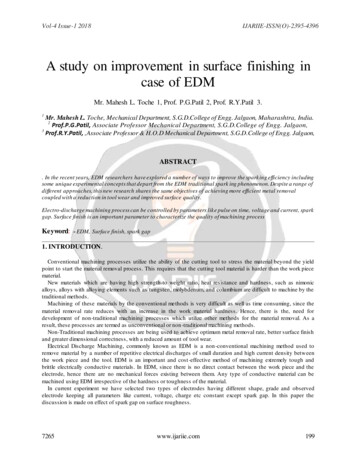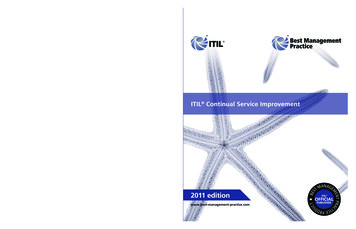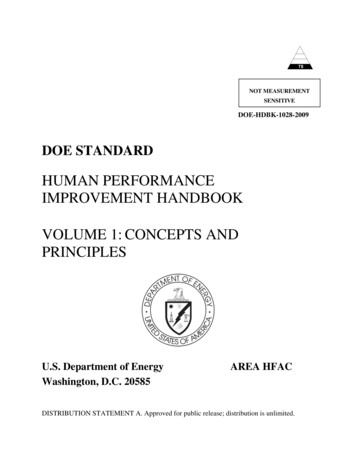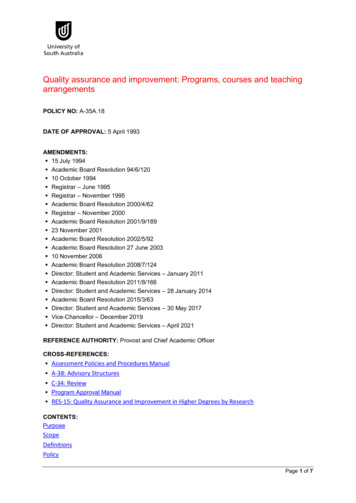
Transcription
Vol-4 Issue-1 2018IJARIIE-ISSN(O)-2395-4396A study on improvement in surface finishing incase of EDMMr. Mahesh L. Toche 1, Prof. P.G.Patil 2, Prof. R.Y.Patil 3.1Mr. Mahesh L. Toche, Mechanical Department, S.G.D.College of Engg. Jalgaon, Maharashtra, India.2Prof.P.G.Patil, Associate Professor Mechanical Department, S.G.D.College of Engg. Jalgaon,3Prof.R.Y.Patil, ,Associate Professor & H.O.D Mechanical Department, S.G.D.College of Engg. Jalgaon,ABSTRACT. In the recent years, EDM researchers have explored a number of ways to improve the sparking efficiency includingsome unique experimental concepts that depart from the EDM traditional spark ing phenomenon. Despite a range ofdifferent approaches, this new research shares the same objectives of achieving more efficient metal removalcoupled with a reduction in tool wear and improved surface quality.Electro-discharge machining process can be controlled by parameters like pulse on time, voltage and current, sparkgap. Surface finish is an important parameter to characterize the quality of machining processKeyword: - EDM, Surface finish, spark gap1. INTRODUCTION.Conventional machining processes utilize the ability of the cutting tool to stress the material beyond the yieldpoint to start the material removal process. This requires that the cutting tool material is harder than the work piecematerial.New materials which are having high strength-to weight ratio, heat resistance and hardness, such as nimonicalloys, alloys with alloying elements such as tungsten, molybdenum, and columbium are difficult to machine by thetraditional methods.Machining of these materials by the conventional methods is very difficult as well as time consuming, since thematerial removal rate reduces with an increase in the work material hardness. Hence, there is the, need fordevelopment of non-traditional machining processes which utilize other methods for the material removal. As aresult, these processes are termed as unconventional or non -traditional machining methods.Non-Traditional machining processes are being used to achieve optimum metal removal rate, better surface finishand greater dimensional correctness, with a reduced amount of tool wear.Electrical Discharge Machining, commonly known as EDM is a non -conventional machining method used toremove material by a number of repetitive electrical discharges of small duration and high current density betweenthe work piece and the tool. EDM is an important and cost-effective method of machining extremely tough andbrittle electrically conductive materials. In EDM, since there is no direct contact between the work piece and theelectrode, hence there are no mechanical forces existing between them. Any type of conductive material can bemachined using EDM irrespective of the hardness or toughness of the material.In current experiment we have selected two types of electrodes having different shape, grade and observedelectrode keeping all parameters like current, voltage, charge etc constant except spark gap. In this paper thediscussion is made on effect of spark gap on surface roughness.7265www.ijariie.com199
Vol-4 Issue-1 2018IJARIIE-ISSN(O)-2395-43962. LITERATURE REVIEW.EDM is an essential operation in several manufacturing processes in some industries, which gives importance tovariety, precision and accuracy. Several researchers have attempted to improve the performance characteristicsnamely the surface roughness, cutting speed, dimensional accuracy and material removal rate. But the full potentialutilization of this process is not completely solved because of its complex and stochastic nature and more number ofvariables involved in this operation (Spedding and Wang, 1997; Scott et al., 1991). Scott et. al. (1991) developedmathematical models to predict material removal rate and surface finish while machining D-2 tool steel at differentmachining conditions. It was found that there is no single combination of levels of the different factors that can beoptimal under all circumstances. Tarng et. al. (1995) formulated a neural network model and simulated annealingalgorithm in order to predict and optimize the surface roughness and cutting velocity of the EDM process inmachining of SUS-304 stainless steel materials. Spedding and Wang (1997) attempted to model the cutting speedand surface roughness of EDM process through the response-surface methodology and artificial neural networks(ANNs). The authors attempted further to optimize the surface roughness, surface waviness and used the artificialneural networks to predict the process performance. Liao et. al. (1997) performed an experimental study usingSKD11 alloy steel as the workpiece material and established mathematical models relating the machine performancelike MRR, SR and gap width with various machining parameters and then determined the optimal parametricsettings for EDM process applying feasible-direction method of non-linear programming. Spedding and Wang(1997) attempted to optimize the process parametric combinations by modeling the process using artificial neuralnetworks (ANN) and characterizing the EDM machined surface through time series techniques. A feed -forwardback-propagation neural network based on a central composite rotatable experimental design is developed to modelthe machining process. Optimal parametric combinations are selected for the process.3. IMPORTANT PARAMETERS OF EDM .Spark on-time (Ton): The duration of time (μs) the current is allowed to flow per cycle. . Material removal isdirectly proportional to the amount of energy applied during this on -time. This energy is really controlled by thepeak current and the length of the on-time.Spark off-time (Toff): the duration of time in between the sparks generated. During this time the molten materialgets removed from the gap between the electrode and the work piece. This parameter is to affect the speed and thestability of the cut. Thus, if the off-time is too short, it will cause sparks to be unstableVoltage (V): It is the potential difference applied between the electrode and the work piece. It is a potential that canbe measure by volt it is also effect to the material removal rate and allowed to per cycle. Voltage is given by in thisexperiment is 50 V.Discharge Current (Ip): It is the current flowing through the electrode and is measured in amp. Current ismeasured in amp Allowed to per cycle. Discharge current is directly proportional to the Material removal rate.Duty cycle (τ): It is the ratio of Ton divided by total cycle time (Ton Toff). It is a percentage of the on -time relativeto the total cycle time. This parameter is calculated by dividing the on -time by the total cycle time (on-time pulse offtime).τ Ton / (Ton Toff)Arc gap (or gap): The Arc gap is distance between the electrode and workpiece during the process of EDM. It maybe called as spark gap. Spark gap can be maintained by servo system.Diameter of electrode (D): It is the electrode of Cu-tube there are two different size of diameter 4mm and 6mm inthis experiment. This tool is used not only as an electrode but also for internal flushing.Over cut – It is a clearance per side between the electrode and the workpiece after the marching operatio n.7265www.ijariie.com200
Vol-4 Issue-1 2018IJARIIE-ISSN(O)-2395-4396Electrode Specification7265ElectrodetypeHK - 1HK - 2HK - 75Size 851.821.82Sp.Resistance oreHardness586472Avg. grainsize 1
Vol-4 Issue-1 2018IJARIIE-ISSN(O)-2395-43964. CONCLUSIONS4.1 Table 1: Square Solid profile graphite electrode trial analysis reportSquare Solid ProfileElectrode TypeHK 1HK 2HK ess0.81.31.690.951.451.80.70.961.2Graph 1: Square Solid profile graphite electrode Surface roughness Vs Spark gap.4.2 Table 2: Rib Solid profile graphite electrode trial analysis report.Rib Solid ProfileElectrode TypeHK 1HK 2HK ie.com202
Vol-4 Issue-1 2018IJARIIE-ISSN(O)-2395-4396Graph 2: Rib Solid profile graphite electrode Surface roughness Vs Spark gap.4.3 Table 3: Circular Solid profile graphite electrode trial analysis report.Circular SolidProfile ElectrodeTypeHK 1HK 2HK 0.30.751.251.640.91.41.750.550.911.15Graph 3 Circular Solid profile graphite electrode Surface roughness Vs Spark gap.7265www.ijariie.com203
Vol-4 Issue-1 2018IJARIIE-ISSN(O)-2395-4396In the current experiment by keeping all the parameter constant except spark gap and observed its effect on surfaceroughness of the workpiece material.As shown in table 1 the spark gap in case of square electrode is increased by 0.1 mm in each reading and the valueof surface roughness varies with the gap.In table 2 the spark gap in case of rib section electrode is increased by 0.06 to 0.07 in each reading and the value ofsurface roughness varies with gap.Thus, from the readings and graphs it is clear that, the surface roughness is directly proportional to the value ofspark gap. Hence high grade of surface finish can achieve by reducing spark gap.5. REFERENCES1)2)Spedding, T. A., Wang, Z.Q. (1997), “Parametric optimization and surface characterization of wire electricaldischarge machining process”, Precision Engineering, 20(1), 5-15.Spedding, T. A., Wang, Z.Q. (1997), “Study on modeling of wire EDM process”, Journal of MaterialsProcessing Technology, 69, 8- 28.3)Scott, D., Boyina, S., Rajurkar, K.P. (1991), “Analysis and optimization of Parameter Combination in WireElectrical Discharge Machining”, International Journal of Production Research, 29, 2189-2207.4)Tarng, Y. S., Ma, S. C., Chung, L. K. (1995), “Determination Of optimal cutting parameters in wire electricaldischarge machining”, International Journal of Machine Tools and M anufacture, 35, 1693-1705)Yan, M.T., Liao, Y.S., Chang, C.C. (2001), “On-line estimation of workpiece height by using neural networksand hierarchical adaptive control of EDM”, International Journal of Advanced Manufacturing Technology, 18,884–891.7265www.ijariie.com204
Surface finish (VDI) 30 24 20 . Vol-4 Issue-1 2018 IJARIIE-ISSN(O)-2395-4396 7265 www.ijariie.com 202 4. CONCLUSIONS 4.1 Table 1: Square Solid profile graphite electrode trial analysis report Square Solid Profile Electrode Type Spark Gap Surface Roughness HK 1 0.1 0.8 0.2 1.3 0.3 1.69 HK 2 0.1 0.95 0.2 1.45 0.3 1.8 HK 75 0.1 0.7 0.2 0.96 0.3 1.2 Graph 1: Square Solid profile graphite electrode .











